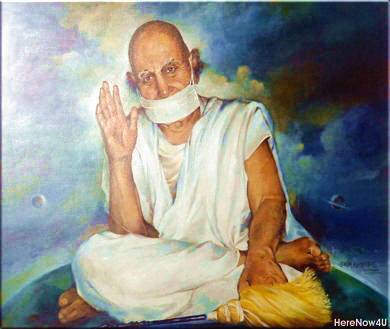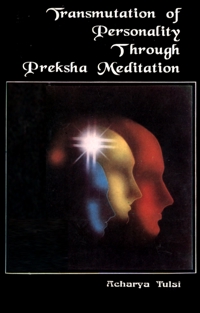
Distress and fury afflict him not,
His meditation is always pure and bright!
Absolutely calm, the conqueror of passions,
Secure, self-integrated, wise!
Always natural, self-aware, victorious over senses!
Generally, the lover of white colour;
Such a one is possessed of Shukla leshya!
Shukla leshya is the most pre-eminent among all theleshyas. Its colour is white. How does the awakening of its vibrations benefit a man?
The white colour is an original and most powerful colour from the point of view of dhyana sadhana. For purity, freedom from defilements and spiritual progress, it has the utmost value. The man visualising the vibrations of the atoms of this colour, would never indulge in mental concentration resulting from a state of distress or fury. Distress-concentration means mental anguish or painful sensations born of attachment to the pleasant and aversion for the unpleasant.
Such sensations are felt only by those whose lives are marked by pain, regret, tension and helplessness. Separation from some dear one in the family becomes unbearable for them. Similarly, assailed by restlessness and extreme impatience because of some disease, they lose their balance altogether.Shukla leshya saves them from all this pain. It increases forbearance and ends impatience. Restlessness caused by like and dislike is also out of place here. The activation of the vibrations of Shukla leshya is absolutely necessary for the development of a steady, stable and healthy mind.
Is the state of Shukla leshya uniformly even, or is there in it an ascending or descending order?
There is no continuity of Shukla leshya. It is not uniformly even. Its excellence lasts for a short while. Generally, three degrees of excellence are recognised: excellent, more excellent and most excellent. The most excellent Shukla leshya is possessed by a veetaraga (one who has transcended all passion).
Shukla leshya of the first degree is commonly found in a tranquil person and Shukla leshya of the second order is found in a person who never loses his equilibrium under any circumstances. The shraman of the standing of one-year's initiation experiences a happiness that exceeds all kinds of known pleasures. This happens only in a state of Shukla leshya. The colour of Shukla leshya is white (bright white). In the case of white colour, chemical changes take place much more quickly. The glands responsible for imparting to us the sensation of pleasure can be stimulated only by the vibrations of this colour.
Fury-ridden concentration like distress-concentration is also an inauspicious thing. In the presence of Shukla leshya vibrations, the feelings of rage or fury just do not originate. Rage or fury culminates in the development of violence, thieving, cruelty, lying on a large scale and negative or destructive feelings. When faced with Shukla leshya, all these above tendencies and feelings suffer a natural diminution.
You have talked about the evils from which a man possessed of Shukla leshya is free. But what are the positive qualities found in him?
The creation of the right environment for meditation is possible only in a state of Shukla leshya. There are also other types of meditation, referred to earlier as distress and fury-ridden concentration. But as a matter of fact, these do not form a part of dhyana sadhana. These only act as hurdles in the way of sadhana. Without the sadhak distancing himself from these, there can be no possibility or development of dharmya or shukla meditation. In the state of Shukla leshya, distress and rage-ridden meditations do not altogether vanish, still their intensity is greatly diminished and the door to introversion is opened.
The foremost objective of introversion is dharmya meditation. It is the discovery of the truth or actuality of what constitutes religion. Unless one enters the depths of dharmya meditation, one can never experience absolute joy, which lies beyond material objects. Material objects can only afford transient pleasure, but such pleasure can never be absolute or complete. Therefore, it is necessary to develop dharmya meditation, and this is possible only in a state of shukla-leshya.
The ultimate stage of introversion is shukla meditation. The consummation of shukla meditation is the flowering of self-realisation. The sadhak who finds himself on the path of self-realisation, is blessed. All material craving then comes to an end and he passes through a state of complete transformation.
What do you mean by self-realization? Does one have a direct experience of the soul in this state? What does actually transpire?
There is an element inside our body, which cannot be experienced from the outside. In the state of self-realisation or soul-realisation, one comes face to face with that element.
One directly experiences the very source of the current. There is no hindrance whatever. One has a direct experience of consciousness.
But very few people reach that stage. Therefore, by self-realisation in the present context we only mean the perception of all kinds of gross and subtle movements of the body, within and without.
Thus, breath-perception is also a part of self or soul realisation, because breath has been recognised as the material apparatus of the soul. The perception of the sense organs is a part of self-realisation. Similarly, the perception of bodily vibrations, or the experiencing of the karma sharir, is also a form of self-realisation. In the very midst of these realisations there comes a moment when one has a direct experience of consciousness.
Consciousness is the fundamental quality of the soul. But in common parlance, the soul has other connotations, too. For example, the sentence "I surrender myself", implies the transcendence of self, of passions, of body-consciousness, and of all that is false. Similarly, victory over oneself, too, implies control over the senses, passions, etc.
Is there any other consummation of the vibrations of Shukla leshya?
Through the vibrations of Shukla leshya, the mind becomes absolutely still, and one achieves control over the passions. The mind, the tongue, and the body are perfectly disciplined, and one's approach is wholesome. Healthfulness ensues, the senses are controlled and awareness suffuses one's whole being. Whether the individual is attached or wholly detached, he always acts spontaneously in the state of Shukla leshya. The colour of this leshya is white; therefore, the aura connected with it is also white and bright.
 Acharya Tulsi
Acharya Tulsi
